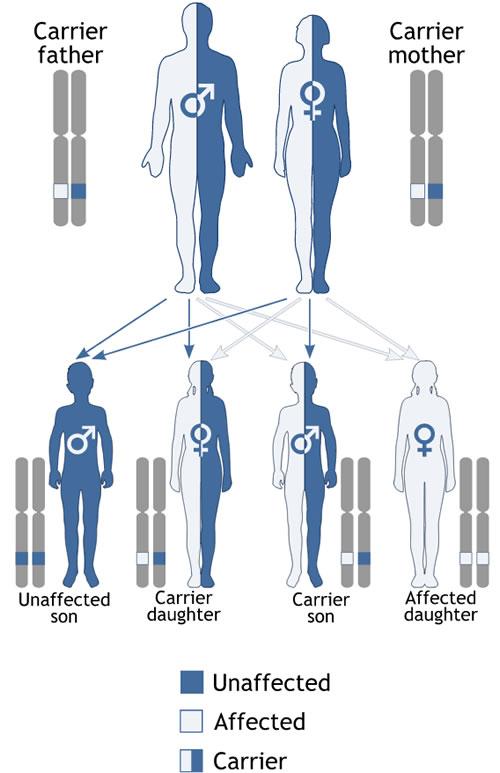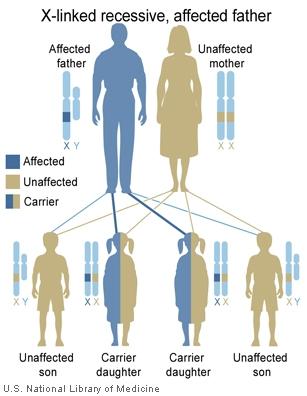Chromosomal theory of inheritance
Genes are located on chromosomes. Chromosomes are in pairs and genes, or their alleles, are located on each of these pairs.
When the cell divides in half, each chromosome ends up in a different cell. This is seen during meiosis in formation of egg cells of sperms. The genes also split into two halves. These are called alleles. Meiotic products have one of each homologous chromosome but not both. Meiosis is a series of cell divisions that creates haploid cells with half of the total number of chromosomes.
Once the egg and sperm meet, the pairs are restored but now the genetic combination of the pair is altered. One of the alleles thus comes from the mother and another from the father. This is how a defective gene causing a genetic disorder is also inherited by offspring.
Gene Linkage on Chromosomes
As per the Mendelian principles of inheritance genes need to be inherited independently of each other. However, there are far more genes than chromosome pairs. It is found that all of the genes on a chromosome are physically inherited together as a single linked group. Only genes that are located on different chromosomes have independent assortment during meiosis.
Crossing-Over and Recombination
According to the chromosomal theory 25% would resemble one parent, 25%, the second parent, 25% would have one trait from one parent and one from the other parent – and 25% would have also have the “other” traits from each parent.
Since each chromosome is a diploid, or occurs in pairs, genes on different chromosomes assort independently during sexual reproduction, recombining to form new combinations of genes. Genes on the same chromosome would theoretically never recombine.
However, genes do undergo cross over. During crossover, chromosomes exchange stretches of DNA, effectively shuffling the gene alleles between the chromosomes. This process of chromosomal crossover generally occurs during meiosis.
The probability of crossover occurring between two given points on the chromosome is related to the distance between the points. If the distance is long there is a higher chance of a crossover. For genes that are closer together, however, the lower probability of crossover means that the genes demonstrate genetic linkage that means that the alleles for the two genes tend to be inherited together. The amounts of linkage between a series of genes can be combined to form a linear linkage map.
Autosomal recessive inheritance
Most genes have a second working copy and one of them may not be actively functional at all. When this is inherited it is known as autosomal recessive inheritance. With recessive genes, it is only if someone inherits two altered copies of the same gene from each of their parents, they are likely to be expressed.
For example, inheritance of thalassemia and cystic fibrosis occurs in an autosomal recessive pattern. If both parents carry the faulty gene on one of their alleles they are likely pass on their defective gene in only 25% of their offspring. The baby of this couple has a 75% chance of not developing the condition. There are also other inherited characteristics that are inherited in this way such as blue eyes or red hair.

Figure 1: Autosomal recessive inheritance. A person who has one altered copy and one working copy of the gene is known as a carrier for that particular altered gene. If two carriers have children together, they have a 25% chance in each pregnancy of their child inheriting two copies of the altered gene and having the condition.
Autosomal dominant inheritance
Sometimes the inherited gene is a dominant one. This means if a person carries even one copy of that gene, he or she is likely to develop the trait. In some dominant conditions, it is possible to inherit an altered gene without showing any signs of the condition: in other words, the gene is not fully penetrant. Examples of genetic conditions that are inherited in a dominant way are Huntington’s disease and Neurofibromatosis type 1 (NF1).
If a parent carries an altered gene for a dominant condition, each of their children has a 50% or 1 in 2 chance of inheriting the altered gene. This is same for all children irrespective of sex of the child.

Figure 2: Autosomal dominant inheritance – If a person who is a carrier for a dominant altered gene has children, there is a 50% chance of their child inheriting the altered copy of the gene.
X-linked inheritance
This is seen when an altered gene is located on the X chromosome (one of the sex chromosomes) rather than on one of the autosomes. Women have two X chromosomes while men have an X and a Y.
If this gene is a recessive one then a woman who carries an altered copy will either have no signs of the condition caused by that gene or will have minor signs of the condition. She is said to be a carrier of that X-linked condition. If a man has an altered gene on his X chromosome, then he will have the condition as he has only one X chromosome.
According to inheritance patterns if the woman has a boy there is a 50% chance that her son will have the condition. If she has a girl, there is a 50% (1 in 2) chance that her daughter will inherit the faulty copy and be a carrier like her mother.
If the father is has the faulty gene inherited from his mother he is likely to pass it on to all (100%) his daughters and they will be carriers themselves. Because men do not pass on their X chromosome to their sons, none of their sons will have the same X-linked condition as their father (0%).
Haemophilia and Duchenne muscular dystrophy as well as red-green colour blindness is inherited this way.

Figure 3: X-linked inheritance – X-linked recessive conditions affect men more often and more severely than women because men only have one X chromosome and women have two X chromosomes so usually have a second working copy of the gene. A woman who is a carrier for an X-linked condition has a 50% chance in each pregnancy of a son having the condition and a 50% chance of a daughter being a carrier for the condition. Men who have an X-linked condition will pass on the altered gene to all their daughters (100%), but none of their sons (0%).
Sources
- scidiv.bellevuecollege.edu/…/ChromosomeInheritance211.pdf
- www.genetics.edu.au/…/Genes-and-Chromosomes-FS1
- http://www.nlm.nih.gov/exhibition/harrypottersworld/pdf/prelesson.pdf
- www.ornl.gov/sci/techresources/Human_Genome/publicat/primer/primer.pdf
- http://www.genome.gov/Pages/Education/Modules/BasicsPresentation.pdf
- http://www.angrau.net/StudyMaterial/GPBR/GPBR111.pdf
Further Reading
- All Chromosomal Crossover Content
- All Genetics Content
- What is Genetics?
- History of Genetics
- Genetics and Gene Expression
Last Updated: Apr 22, 2019

Written by
Dr. Ananya Mandal
Dr. Ananya Mandal is a doctor by profession, lecturer by vocation and a medical writer by passion. She specialized in Clinical Pharmacology after her bachelor's (MBBS). For her, health communication is not just writing complicated reviews for professionals but making medical knowledge understandable and available to the general public as well.
Source: Read Full Article



